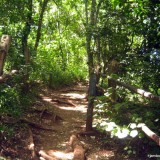Camping Stoves in Kenya
Updated 11 March 2021
Portable camping stoves are indispensable for hikers and campers visiting the Aberdares Ranges, Mt Kenya, and Mt Elgon National Parks. Campfires are generally not permitted in these places due to the risk of forest fires. These are backpackers country, where one has to carry their camping stoves, kitchen sets, food and other necessities on their backs for the duration of their hiking trip, ranging from a few days to several weeks.
Weight is a major consideration when choosing camping stoves and all other items you will lug around while backpacking. The availability of the appropriate fuel for your stove here in Kenya is another consideration. Let’s not forget that if you are a visitor from another country, no airline will agree to carry compressed gas canisters or any combustible liquid fuel you may try to bring with you. With these factors in mind, let’s review the various options of camping stoves available, and which ones you can or cannot use in Kenya.
Most camping stoves fall under two categories, liquid fuel stoves and canister fuel stoves.
Liquid Fuel Stoves

Petroleum based Liquid fuel camping stoves require pre-heating for a short duration, and priming to get them going. Once fully operational, they get your water to a boil much faster than any other type of camping stoves, will work in sub-zero temperatures, and their fuel (kerosene, petrol etc) is widely available and cheaper than gas canister fuels. On the downside, they make quite a racket, they are heavier than gas stoves, the fuel can be smelly if it spills on your hands or in your bag, and they require field maintenance from time to time to unclog them.

You’ll find Optimus Stoves and their fuel cans at Going Outdoor in Galleria Mall. You can buy fuel for this and other multi-fuel stoves from any Petrol station.
Canister Fuel Stoves
Canister fuel camping stoves burn petroleum gases (Butane, Isobutene, Propane) stored in non-refillable gas canisters. These camping stoves are very light, burn cleanly and more quietly than the liquid fuel types, cook fairly fast, and do not require any maintenance. On the downside, their fuel is more expensive than liquid fuels, they are not as widely available, and the stove’s effectiveness diminishes at sub-zero temperatures. In addition, you have to find a way to shield their flame from strong winds, balance the stove on uneven surfaces, and you have to carry exhausted canisters while on a hike until you get to a place where you can safely dispose them.
In the old days, canister camping stoves used to be mounted on puncture type canisters, and had to stay mounted until the gas was exhausted. An example of this is the Campingaz Bleuet 206 stove that uses Campingaz C206 canisters. Lately, these types have fallen out of favour with backpackers.

In Kenya, you’ll find Campingaz CV470 Plus and CV270 Plus, as well as Coleman and CADAC gas canisters at Going Outdoor in Galleria Mall.
Alcohol Stoves

Trangia and Tatonka, one of the other well established brands, often package their alcohol stoves with a lightweight cooking set of pots, pans and a kettle.
You’ll find Trangia stoves at RhinoLeisure off Karen Road in the Karen area of Nairobi, and Tatonka Multi set burner and cookware at Xtreme Outdoors in Yaya Centre and Westgate Mall. Methylated spirit is sold in Supermarkets and hardware shops countrywide.
Summary| Camping Stove | Where to buy |
| Liquid Fuel Stove Optimus Optifuel: Fuel: petrol, paraffin, jet fuel, diesel Weight: 475g | Stove: Going Outdoor Fuel: Petrol Stations |
| Canister Fuel Stoves Campingaz Stoves (several models) Super Carena Stove Fuel: Campingaz, Coleman and CADAC canisters | Stove: Going Outdoor Canisters: Going Outdoor |
| Alcohol Stove Trangia 25 series, Tatonka Multi set Fuel: methylated spirit Weight: 865g inclusive of cooking set. | Stove: RhinoLeisure, Xtreme Outdoor Fuel: Supermarkets and Hardware shops |

























the one thing that none of these stoves do that is perfect for the Kenyan market is: roast meat while keeping you warm and providing a source of entertainment.
They may be a bit heavier, but being able to bake fresh bread on safari and roast potatoes for dinner on a national fuel (charcoal) is priceless.
Very intersting piece. Away from the firewood and in an effort to preserve our forest, a camping stove is a must have for all campers and avid backpackers.
wait, so using LPG gas looted and raped from the ground in Nigeria, Lybia, Baghdad, and South Sudan is a good thing instead of Kenyans just planting their own firewood?
do you own shares in an oil co?
cool idea for campers, being a scout and a expeditious man, i like this
Its nyce but have energy efficient jiko good for camping replacing kerosene which is not enviroment friendly and hazardous to your health,this jiko you only use branches of wood which fall from trees as you walk the forest.